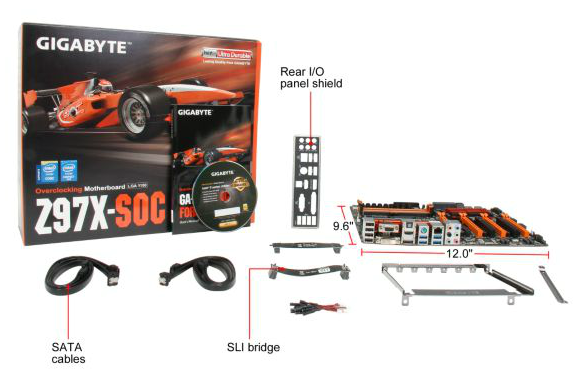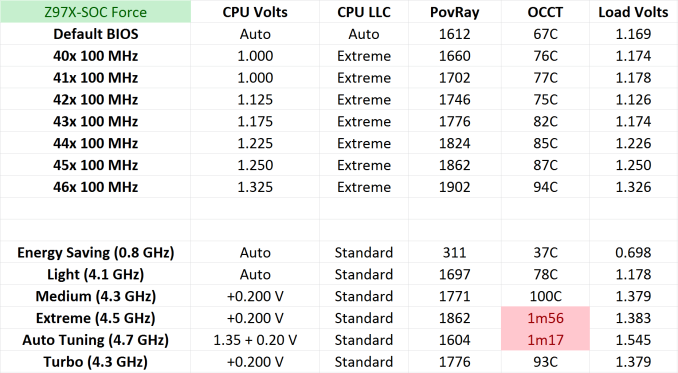GIGABYTE Z97X-SOC Force Review
by Ian Cutress on June 17, 2014 1:00 PM EST- Posted in
- Motherboards
- Gigabyte
- Overclocking
- Z97
GIGABYTE Z97X-SOC Force In The Box
Much like with the 8-series overclocking range of motherboards, trying to hit that $200-$220 price point can be tricky. In the past, overclocking oriented motherboards go north of $250 and $300, making it easier to include extras in the box and make the purchase of the motherboard seem more than just a functional entity in order to get the system up and running. Down at $200, the Z87X-OC we reviewed had a similar issue – the cheaper end of the overclocking oriented market does not get much to make their purchase feel extra special. Similarly the Z97X-SOC Force comes with the bare essentials:
Driver Disk
Manual
Rear IO Shield
Four SATA Cables
SLI Bridge
Crossfire Bridge
Voltage Check Point cables
OC Brace
The inclusion of a Crossfire bridge is not too common and a good part from GIGABYTE, and the four SATA cables mimics what most users will eventually use the system for. We looked at the OC Brace with the Z87X-OC and the same conclusion holds true – for a system on a desk without plastic standoffs, it does aid in keeping GPU spacing consistent and is a nice addition. At my trip to GIGABYTE HQ last year, they showed me several iterations of the design, meaning that the OC Brace was a proper, well thought out project with gradual improvements to the final shape. The OC Brace still has limited appeal to the wider audience though, as with the motherboard inside a case it no longer has any use.
GIGABYTE Z97X-SOC Force Overclocking
Experience with GIGABYTE Z97X-SOC Force
While the automatic overclocking in the OS usually provides a good viewpoint in which to start manual overclocking, I feel that GIGABYTE’s automatic overclocking implementation is somewhat overly aggressive. Our test i7-4770K is somewhere around average in terms of overclock ability, normally hitting 4.6 GHz stable at around 1.35 volts (which is roughly the limit for a standard Haswell CPU in terms of voltages and temperatures on air). The GIGABYTE system goes straight for the jugular in the medium overclocking preset, with 1.380 volts on loading. This pushes the temperature right up (100C load recorded) when there is no need. It is true that some CPUs need that much voltage for 4.3 GHz (I had one), but having that much voltage period is almost criminal unless the CPU is a golden sample. This situation is overly compounded by the automatic tuning option, which implements a 1.545 volt overclock. GIGABYTE needs to implement a system that asks what the cooling is on the system and implement voltages accordingly otherwise they might be left behind in automatic overclocking options compared to their rivals.
For manual overclocking, our CPU was the limiting factor similar to the other reviews. It hit 4.6 GHz at 1.325 volts, with 94C as the peak temperature during 5 minutes of OCCT loading. Users should note that to adjust some of the frequencies in the OS using the buttons on the motherboard, the driver has to be installed from the CD.
Methodology:
Our standard overclocking methodology is as follows. We select the automatic overclock options and test for stability with PovRay and OCCT to simulate high-end workloads. These stability tests aim to catch any immediate causes for memory or CPU errors.
For manual overclocks, based on the information gathered from previous testing, starts off at a nominal voltage and CPU multiplier, and the multiplier is increased until the stability tests are failed. The CPU voltage is increased gradually until the stability tests are passed, and the process repeated until the motherboard reduces the multiplier automatically (due to safety protocol) or the CPU temperature reaches a stupidly high level (100ºC+). Our test bed is not in a case, which should push overclocks higher with fresher (cooler) air.
Overclock Results:












17 Comments
View All Comments
apertotes - Tuesday, June 17, 2014 - link
I am glad to know that they moved fan control out of Easy Tune. Do you know if this improvement will carry on to Z87 motherboards also?Lucian2244 - Wednesday, June 18, 2014 - link
I think they already did, on my mobo (z87mx-drh) i see the system information viewer available for download, the last time i checked easy tune it didn't have the smart fan option anymore.GeorgeH - Tuesday, June 17, 2014 - link
Do I need to calibrate my monitor? I already knew that the graphics cards are not included (4-Way graphics support picture, 1st page).isa - Tuesday, June 17, 2014 - link
Boards have really become things of beauty that are also well thought-out like the colocation of all the OC buttons on this board. But I'm a bit stumped that there are OC boards distinct from gaming boards: aren't gamers the primary customers of OCing? Not just a nit: I wanted the best effort on audio on this, and it's not available because this isn't a gamer board?Flunk - Tuesday, June 17, 2014 - link
No, there is a group of people who just try to get the most out of their hardware for no real reason. Just so they can say they did. These are the same people cooling with liquid nitrogen, which is totally impractical. They don't care about performance or what they're doing with the computer. It's all about the numbers and bragging rights.If you're a gamer your needs would be better served with a gaming-focused board. The only reason a gamer would want to pick this up is if it was going really cheap.
BMNify - Wednesday, June 18, 2014 - link
ian, can you check please the ram compatibility as regards using 4 generic 1333 dimm's in all these gigabyte boards, as it seems that many have a big problem even posting with 4 dimms installed including my gigabyte Z87M-D3H that's had all the bios installed through factory to currently 11a for that board an still only 2 dimms (in the dimm3 and dimm4 slots) will post and work in single channel mode, no matter what 3 or 4 dimms will not even post never mind boot and function for a time before as per other reports crashing....it seems many gigabyte boards with 4 dimm slots have massive problems with no sign of a bios fix that actually works for generic (fully tested individually as god) 1333 dimm's
cylemmulo - Wednesday, June 18, 2014 - link
How the hell would you get the front panel connectors on when you had quad cards?bj_murphy - Wednesday, June 18, 2014 - link
Just FYI, I think you linked an i7-4820K instead of an i7-4770K in your build sheet.Narg - Thursday, June 19, 2014 - link
I'm still waiting for a bare-bones power board. All the performance, but no extra features that I really don't need or want. The most important one is on-board sound. Don't need it, don't want it. I will ALWAYS use a card for sound. Always. Video on-board is not needed either.Wall Street - Saturday, June 21, 2014 - link
This is about as bare bones as you will find. Much of the HD audio and networking functionality is built into the chipset. Although an ethernet PHY and an audio DAC are required to implement this, it would be a waste not to include this functionality because it is basically "free" with 90% of the digital side of these functions happening in the Z97 chipset itself. It would be like a motherboard maker not including any PCI-E or USB 3 ports, if Intel does all of the work, why not?